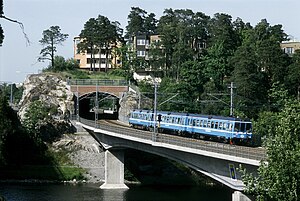Roslagsbanan
| Roslagsbanan | |||||||||||||||||||||||||||||||||||||||||||||||||||||||||||||||||||||||||||||||||||||||||||||||||||||||||||||||||||||||||||||||||||||||||||||||||||||||||||||||||||||||||||||||||||||||||||||||||||||||||||||||||||||||||||||||||||||||||||||||||||||||||
|---|---|---|---|---|---|---|---|---|---|---|---|---|---|---|---|---|---|---|---|---|---|---|---|---|---|---|---|---|---|---|---|---|---|---|---|---|---|---|---|---|---|---|---|---|---|---|---|---|---|---|---|---|---|---|---|---|---|---|---|---|---|---|---|---|---|---|---|---|---|---|---|---|---|---|---|---|---|---|---|---|---|---|---|---|---|---|---|---|---|---|---|---|---|---|---|---|---|---|---|---|---|---|---|---|---|---|---|---|---|---|---|---|---|---|---|---|---|---|---|---|---|---|---|---|---|---|---|---|---|---|---|---|---|---|---|---|---|---|---|---|---|---|---|---|---|---|---|---|---|---|---|---|---|---|---|---|---|---|---|---|---|---|---|---|---|---|---|---|---|---|---|---|---|---|---|---|---|---|---|---|---|---|---|---|---|---|---|---|---|---|---|---|---|---|---|---|---|---|---|---|---|---|---|---|---|---|---|---|---|---|---|---|---|---|---|---|---|---|---|---|---|---|---|---|---|---|---|---|---|---|---|---|---|---|---|---|---|---|---|---|---|---|---|---|---|---|---|---|---|
|
Roslagsbanan train on the new Stocksund Bridge
| |||||||||||||||||||||||||||||||||||||||||||||||||||||||||||||||||||||||||||||||||||||||||||||||||||||||||||||||||||||||||||||||||||||||||||||||||||||||||||||||||||||||||||||||||||||||||||||||||||||||||||||||||||||||||||||||||||||||||||||||||||||||||
|
Joint logo of the urban and suburban railways
| |||||||||||||||||||||||||||||||||||||||||||||||||||||||||||||||||||||||||||||||||||||||||||||||||||||||||||||||||||||||||||||||||||||||||||||||||||||||||||||||||||||||||||||||||||||||||||||||||||||||||||||||||||||||||||||||||||||||||||||||||||||||||
| Route length: | 41.5 km | ||||||||||||||||||||||||||||||||||||||||||||||||||||||||||||||||||||||||||||||||||||||||||||||||||||||||||||||||||||||||||||||||||||||||||||||||||||||||||||||||||||||||||||||||||||||||||||||||||||||||||||||||||||||||||||||||||||||||||||||||||||||||
| Gauge : | 891 mm ( Swedish 3-foot track ) | ||||||||||||||||||||||||||||||||||||||||||||||||||||||||||||||||||||||||||||||||||||||||||||||||||||||||||||||||||||||||||||||||||||||||||||||||||||||||||||||||||||||||||||||||||||||||||||||||||||||||||||||||||||||||||||||||||||||||||||||||||||||||
| Power system : | 1500 V = | ||||||||||||||||||||||||||||||||||||||||||||||||||||||||||||||||||||||||||||||||||||||||||||||||||||||||||||||||||||||||||||||||||||||||||||||||||||||||||||||||||||||||||||||||||||||||||||||||||||||||||||||||||||||||||||||||||||||||||||||||||||||||
| Top speed: | 80 km / h | ||||||||||||||||||||||||||||||||||||||||||||||||||||||||||||||||||||||||||||||||||||||||||||||||||||||||||||||||||||||||||||||||||||||||||||||||||||||||||||||||||||||||||||||||||||||||||||||||||||||||||||||||||||||||||||||||||||||||||||||||||||||||
|
|||||||||||||||||||||||||||||||||||||||||||||||||||||||||||||||||||||||||||||||||||||||||||||||||||||||||||||||||||||||||||||||||||||||||||||||||||||||||||||||||||||||||||||||||||||||||||||||||||||||||||||||||||||||||||||||||||||||||||||||||||||||||
The narrow-gauge railway line Roslagsbanan with a gauge of 891 mm connects the northeastern suburbs of Stockholm with the Swedish capital. The name refers to the Roslagen region , in which there are several stations. It is a remainder of the network of the Stockholm – Roslagens Järnvägar AB (SRJ) railway company . Originally, the entire network of this society was known colloquially as Roslagsbanan.
history
The story up to 1972 is covered in the article about Stockholm – Roslagens Järnvägar . The line ribbon on the right shows the route network between Stockholm and Rimbo at the time of handover to SL with the later changes.
Takeover by SL
On May 1, 1972, the Swedish state railway company Statens Järnvägar (SJ) handed over the remaining electrified lines of the Stockholm – Roslagens Järnvägar south of Rimbo together with the vehicles to Storstockholms Lokaltrafik (SL). SL operates regional traffic on these routes under the name Roslagsbanan , the slang term for the former overall network. The northernmost section between Kårsta and Rimbo was completely shut down by SL in January 1981 and then dismantled. Since then, the former Rimbo railway junction has been without any siding.
Closure of the Djursholmsbahn
From August 27, 1973, SL reduced the traffic on the Djursholms Railway Djursholms Ösby - Eddavägen to one pair of trains per day. On January 1, 1976, this section of the line was closed and then dismantled.
Realignment at Stocksund
In the course of the double-track expansion, the route at Stocksund was changed in 1996. The former single-track swing bridge over the Stocksund was replaced by a fixed, double-track bridge a few hundred meters further west. The Sikrenoberg immediately north of the Stocksund, which the old route had bypassed, was tunneled under. A new Stocksund stop was built directly at the northern tunnel portal. The old route was built over partly by roads, partly by footpaths and cycle paths. The former Stocksund train station has been without a siding since then, and the listed station building from 1904 is used as a residential building.
The route network today
The main line of today's Roslagsbana is the section of Stockholm's östra – Kårsta of the former main line of the SRJ. From this branch in Djursholms Ösby the route to Näsbypark, which was also originally built by the SRJ, branches off. In Roslags Näsby, the former Södra Roslags Kustbana branches off to Åkersberga. All of these lines are electrified with 1500 volts direct current and equipped with the ATC train control system. The owner is the company AB Storstockholms Lokaltrafik . The Roslag Railway has been expanded, modernized and double-tracked on numerous sections since 2010. The Visinge – Täby kyrkby, Kragstalund – Vallentuna and Rydbo – Åkers Runö sections have been operated on two tracks since autumn 2014, and the Roslags Näsby – Visinge section since 2017. The double-track expansion of further sections is in preparation.
The most important addition is the construction of a branch line from Vallentuna to Arlanda Airport , which will drastically shorten travel times by public transport and reduce emissions of greenhouse gases . The profitability of the route has been called into question, however, and no specific decisions have yet been made.
Other projects discussed are the reconstruction of the Kårsta – Rimbo and Rimbo – Norrtälje sections. Both cities currently have busy bus connections to Stockholm. Since a railway line from Norrtälje via Rimbo to Stockholm would save almost no time compared to the current bus traffic, a new line parallel to the E18 motorway is also being discussed, which would then meet the Roslagsbana near Täby.
Finally, there are concrete plans to give up the current terminus of Stockholms östra and instead lead the train in a tunnel to Odenplan and on to the main station. Work on this will begin in 2020.
| line | route | length | Stations |
|---|---|---|---|
| L27 | Stockholms östra - Kårsta | 41.5 km | 22nd |
| L28 | Stockholms östra - Österskär | 29.5 km | 19th |
| L29 | Stockholms östra - Näsbypark | 11.5 km | 11 |
| Total | 65.0 km | 38 | |

|
|||
vehicles
Today's vehicles
SL X10p
The X10p railcars are approved for a top speed of 80 km / h and were built between 1988 and 1995. The trains were modernized between 2012 and 2016. Among other things, the intermediate cars were equipped with a low-floor section to enable barrier-free access. The service life of the trains is to be extended until after 2025.
SL X15p
In 2016, 22 new trains were ordered from Stadler Rail . The new trains will have the series designation SL X15p and will be delivered from 2020. The trains are designed for a speed of 120 km / h and can accommodate 300 passengers, 150 they offer a seat.
Historic vehicles
SL X2p
The vehicles of the SL X2p series were built by ASEA for the SRJ from 1918 to 1919. Three vehicles were built. They had the Bo'Bo ' wheel arrangement, an engine output of 280 kW, a top speed of 60 km / h and offered 56 seats for travelers. Because of their wooden exterior, they were nicknamed Träburkar ( wooden boxes ). They were not handed over to SL and retired in 1975. The railcar with the serial number 33 has been preserved as a non-operational museum vehicle, the others were scrapped.
SL X3p
Only two vehicles of the SL X3p series were built by ASEA in 1934. They were largely identical in construction to the SL X2p built between 1918 and 1919 and also adopted the nickname Träburkar from them . Both railcars of this type were handed over to SL in 1972 and drove there until 1993. Serial number 36 was then scrapped, while serial number 35 has been preserved as an operational museum vehicle and is used for special trips on the Roslag Railway.
SL X4p
A total of nine vehicles of this series were built between 1938 and 1940. They initially drove under the serial numbers 121 to 129 on the Djursholmsbahn. Later they were assigned the serial numbers 37-45 in the numbering scheme of the Roslag Railway. In contrast to the older series, the car bodies were clad with sheet steel and no longer with wood. Vehicle no. 37 is still operational as a museum vehicle.
SL X7p
A total of eleven vehicles of the SL X7p series were also built by ASEA between 1946 and 1949. Six of them were converted between 1984 and 1985 for operation with control cars. From 1990 onwards, the railcars were gradually replaced, retired and scrapped by the new X10p series. The vehicle with the serial number 54 has been preserved in an inoperable condition and is now in the Stockholm Tram Museum, Stockholms Spårvägsmuseum .
SL X9p
The railcars of the SL X9p series were again built by ASEA in sheet steel construction. Four vehicles were built and delivered in 1962. Similar to the SL X7p series, these were also equipped for operation with control cars between 1984 and 1985, but were retired from 1990. No vehicle from the SL X9p series has survived.
business
In Stockholms östra you can change directly to the red line of the Stockholm subway (station Tekniska Högskolan ) and to numerous bus lines, etc. a. possible to Vaxholm and Norrtälje . Operation has been with Arriva Sverige , a subsidiary of DB Arriva , which won a corresponding tender, since January 2013 . Arriva made international headlines in the summer of 2013 because some of the male staff started work in skirts because the employer did not allow shorts on the trains despite the high temperatures.
The trains generally run every 15 minutes, and express trains are used in rush hour traffic. An average of 38,000 people use the Roslagsbanan every day. The transport performance is 2.5 million train kilometers per year.
The Dannemora – Hargshamn and Uppsala – Faringe lines are still in operation. The Dannemora – Hargshamn line has been converted to standard gauge and is only used for freight traffic. Uppsala – Faringe is now operated as a museum railway.
Web links
- Roslagsbanans historia. Roslagsbanans Veterantågsförening, March 3, 2014, accessed April 8, 2014 (Swedish).
- Roslagsbanans historia. In: Trafikminnen. Retrieved April 8, 2014 (Swedish).
Individual evidence
- ↑ Storstockholms Lokaltrafik: Roslagsbanan 100 år , Stockholm, 1985 (Swedish).
- ↑ Rolf Sten: Snabbfakta Stockholm - Roslagens Järnvägar. In: Historiskt om Svenska Järnvägar. July 16, 2002, accessed April 2, 2014 (Swedish).
- ↑ Roslagsbanan. järnväg.net, accessed January 6, 2017 (Swedish).
- ↑ Marianne Gundmark: Bygga collectively trafik - Roslagsbanan. (No longer available online.) Stockholms läns landsting, February 23, 2014, archived from the original on January 19, 2014 ; Retrieved April 8, 2014 (Swedish). Info: The archive link was inserted automatically and has not yet been checked. Please check the original and archive link according to the instructions and then remove this notice.
- ↑ Preliminary study of a cross-connection between Roslagsbanan and Arlanda (Swedish) ( Memento of the original from December 25, 2015 in the Internet Archive ) Info: The archive link was inserted automatically and has not yet been checked. Please check the original and archive link according to the instructions and then remove this notice.
- ↑ Anna Gustafsson: Arlandaspår får tummen ner. Svenska Dagbladet, December 11, 2012, accessed March 11, 2014 (Swedish).
- ^ Reidar Carlsson: Tåg via Rimbo är en dålig idé. Norrtelje Tidning, June 13, 2012, accessed April 8, 2014 (Swedish).
- ↑ Roslagsbanan till city. (No longer available online.) Stockholms läns landsting, April 3, 2017, archived from the original on April 17, 2017 ; Retrieved April 16, 2017 (Swedish). Info: The archive link was inserted automatically and has not yet been checked. Please check the original and archive link according to the instructions and then remove this notice.
- ^ Evelina Hertz, Albin Tingstedt, Josefine Thureson Kämpe: Roslagsbanan till T-centralen tidigareläggs. Stockholmdirekt, October 14, 2019, accessed November 26, 2019 (Swedish).
- ↑ Upprustade and nya tåg på Roslagsbanan. Stockholms läns landsting, accessed January 27, 2017 (Swedish).
- ↑ Another success in Sweden: Stadler delivers 22 customized electric multiple units to Stockholm. In: Bahnonline.ch. April 24, 2017. Retrieved May 7, 2018 .
- ↑ SL body in nya tåg till Roslagsbanan. (No longer available online.) Stockholms läns landsting, August 24, 2016, archived from the original on January 27, 2017 ; Retrieved January 27, 2017 (Swedish). Info: The archive link was inserted automatically and has not yet been checked. Please check the original and archive link according to the instructions and then remove this notice.
- ↑ SL X2p. AB Storstockholms Lokaltrafik suffered X2p nr 32–34. Svenska Spårvägssällskapet, accessed October 12, 2014 (Swedish).
- ↑ SL X3p. AB Storstockholms Lokaltrafik suffered from X3p nr 35-36. Svenska Spårvägssällskapet, accessed October 12, 2014 (Swedish).
- ↑ SL X4p. AB Storstockholms Lokaltrafik suffered from X4p nr 37-45. Svenska Spårvägssällskapet, accessed October 12, 2014 (Swedish).
- ↑ SL X7p. AB Storstockholms Lokaltrafik suffered X7p nr 46–56. Svenska Spårvägssällskapet, accessed October 12, 2014 (Swedish).
- ↑ SL X9p. AB Storstockholms Lokaltrafik suffered X9p nr 57-90. Svenska Spårvägssällskapet, accessed October 12, 2014 (Swedish).
- ↑ jst: DB Arriva wins in Stockholm . In: Eisenbahn-Revue International 2012/1, p. 41.
- ↑ Airy protest in Stockholm: Train drivers wear skirts on duty. Spiegel Online, June 10, 2013, accessed March 11, 2014 .





